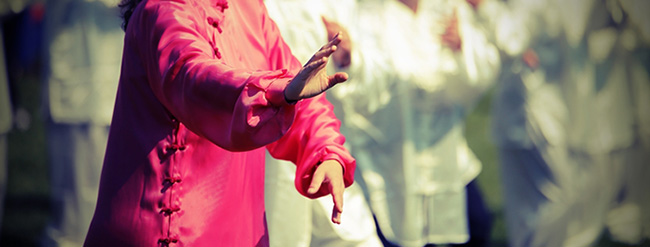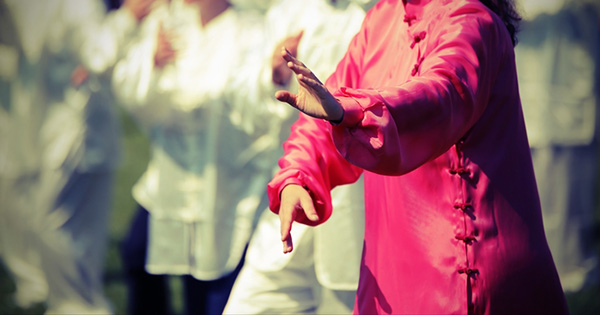
“The Taiji Boxing Treatise of Wang Zongyue of Shanxi” (山右王宗岳太極拳論) as presented in Li Yiyu’s (李亦畬) 1881 manual (as translated by Paul Brennan) states:
“There are many other schools of martial arts besides this one. Although the postures are different between them, they generally do not go beyond the strong bullying the weak and the slow yielding to the fast. The strong beating the weak and the slow submitting to the fast are both a matter of inherent natural ability and bear no relation to skill that is learned. Examine the phrase ‘four ounces moves a thousand pounds’, which is clearly not a victory obtained through strength. Or consider the sight of an old man repelling a group, which could not come from an aggressive speed.”
From this, we can infer that strength, speed, youth, etc. are matters of “natural” abilities that are different than what is developed through the practice of Taijiquan (太極拳). “External” styles of martial arts seek to increase these “natural” abilities, becoming stronger, quicker, and with increased endurance, for example. My understanding is that “internal” martial arts like Taijiquan tend to focus instead on fundamentally altering “natural” attributes until the altered principles become natural to the practitioner.
Some school traditions talk about Taijiquan as using “natural” principles. But Wang’s treatise further states (Brennan translation) that “Although there is an endless variety of possible scenarios, there is only this single principle [of yielding and sticking] throughout.” So, if this is what distinguishes Taijiquan, is this principle of yielding and sticking throughout a natural quality?
I do not think that it is. What is natural for humans is the fight-or-flight response. We tend to either resist (fight) pressure, or retreat (flee) away from it. Taijiquan instead works on something in between these two – we seek to stick-adhere-connect-follow (zhan nian lian sui 粘黏連隨), which is controlling a partner/opponent through contact without resisting (fighting) and without collapsing (fleeing).
Part of the reason that it is so difficult for practitioners to accomplish this skill (of yielding and sticking throughout) is that it goes counter to our natural instincts. In order to accomplish it, we need a calm awareness that allows us to avoid anger (fight) or fear (flight). We need to have a neutral, ego-less mentality; we want to avoid likes (seeking, or going towards, what we desire) and dislikes (going away from or avoiding what bothers us). We need a body that is capable of fluid and controlled movements without the tensions or the slackness that would inhibit the ability to fluidly change in order to match another person’s movements. We should not resist (fight), but also should not separate (flee).
While having a calm mind during conflict is not unique to Taijiquan, it is also not natural; people typically freeze, flinch, tense (e.g., instinctively locking our joints in order to become “stronger” when under pressure), panic, or get angry, for example. It takes training and familiarity being in conflicts to overcome our natural tendencies. Taijiquan may be somewhat different than many other martial arts in that aggression is not cultivated; we train to remain calm and to use an opponent’s aggression against them.
Even solo practice reveals that Taijiquan often does not follow “natural” movements. For example, normal walking is more of a controlled fall, where our forward momentum has us falling forward, at least until our rear leg moves in front of us to catch us and prevent us from actually falling down. Taijiquan practices maintaining balance as the foot moves forward. Unlike natural walking, Taijiquan walking can be done quite slowly since we never lose our balance (we never begin falling forward).
An untrained (or unaware) person might “naturally” tend to bend over at the waist to pick something up from the ground. We need reminders to use the legs (to squat) when picking up heavy items in order to avoid injuring our back. In Taijiquan, we also need reminders to remain upright in our training, especially when engaging in push-hands (tui shou 推手) play or sparring. Wang (Brennan translation) states: “With your head-top pressing up naturally and energy sinking down to your elixir field, there will be no leaning in any direction.”
There is a tendency for humans to lead with their head, since our major senses (especially eyesight) are located here. For some people this may lead to a forward lean of the torso, in other people it may result in the chin jutting forward. These “natural” actions would be considered as errors in Taijiquan because it is often easiest to influence someone to go in the direction that their head is leaning. This is because the weight of the head is, on average, about 8% of the mass of one’s body, and this weight is located on the body’s uppermost tip and can therefore lead one’s entire body.
Because our sense of touch is so dominant in our hands, we “naturally” reach out with the hand without thinking about connecting it, or driving it, with our body. Often we try to open doors or pick up objects, etc. just by using our hand and arm. Only if the object ends up being heavier, or more difficult to handle than we expect, do we try again with better support and better full body coordination. This can be expected because of the way that we receive information from our environment, which is reflected in the “cortical homunculus” or neurological map as discussed in the following Wikipedia article: https://en.wikipedia.org/wiki/Cortical_homunculus.

Leave a Reply